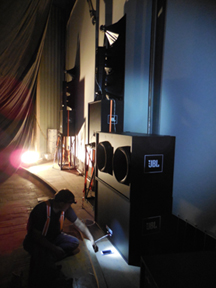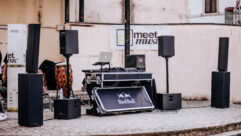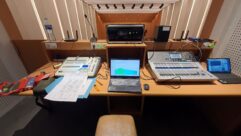
SVC Podcast – Show Notes – Show 142-1:
In this edition of the SVC Podcast, SVC Contributing Editor Bennett Liles talks with David Lewis of Hoffman Pro Systems in Spokane, Washington regarding their sound system upgrade at the historic Garland Theater. The venue had an old system that had become unreliable and unworthy of the grand facility. New speakers, subs and DSP were installed and gave the place a new life. David details the timeline challenge and the steps taken to get everything done right and on time.
Links of interest:
- Hoffman Pro System in Spokane, Washington
- The historic and newly upgraded Garland Theater
- Furman CN-2400s SmartSequencer
- JBL 4642A Dual 18-inch subwoofer
Download Podcast Here:
https://s3.amazonaws.com/nb-svc/public/public/142-1_Hoffman_Pro_Systems_…
From Sound & Video Contractor Magazine, this is the SVC Podcast with David Lewis. Show notes for the podcast are available on the web site of Sound & Video Contractor Magazine at svconline.com.
The Garland Theater in Spokane, Washington is a grand old place and a very popular venue but its AV system had seen better days. They called in local AV contractor Hoffman Pro Systems to revamp the whole sound system. David Lewis is here to give us the story on how they pulled off this huge job in record time. That’s coming up next on the SVC Podcast.
David, it’s very good to have you with us on the SVC Podcast from Hoffman Pro Systems in Spokane, Washington. So tell us about what’s been going on at Hoffman Pro Systems. How long has that outfit been around?
Well, Hoffman Music has been here in Spokane for over 100 years now. We celebrated our 100-year anniversary a couple of years ago. Hoffman Pro Systems, which we are the design/install side, has been around since – about the year 2000 is when we really opened that up. And I’ve been with them going on five years now. And we do the typical design/install service; house for worship, theaters, bid contract projects.
Well, it appears that you don’t shrink from the big and tough jobs because I was looking at the details on the sound renovation of the Garland Theater in Spokane and that’s an old place, but it’s been through several revamps. Describe the Garland Theater for us. What were the problems they had with the old AV system?
The theater has been there many years. I remember actually going to the theater when I went to school out at Eastern here at Cheney and attending movies there as a student. So it was a lot of fun when we got the call to go up there and look through the AV system that was there prior to this one; had been there since the late 1980’s/1990’s was the best they could give me for dates. And that matches, for equipment, what we found there. But the system had just been going down over age and had certainly done its job. And we found it to be a little lacking, particularly in the subwoofers, things like that. The surround speakers were showing a lot of age and an older amplifier. So we just looked at it from the standpoint of upgrading everything we could that would stay within the client’s budget and desires. The owner, Kathy, and her manager, Tana, made a decision about three years ago that they were going to keep the theater open, and it is an independent theater here in Spokane, one of the last ones – one of the largest theaters here in Spokane seating over 600. So we went and have worked with them to keep the old system running until they finally said, “We’re going to redo everything.” And they did a beautiful job. You know, new video source, new audio and redid the entire interior. [Timestamp: 3:10]
Well, I know that anyplace that’s described as having historic architecture, you may have some problems. So were there any special challenges with the building itself on cabling and rigging and all that?
The nice thing is, is that their attic space is totally walkable. It has full lighting up there, which was wonderful. And then we were able to pull all the cable; and a lot of the cable existed from the previous system. However, hanging new surround sounds and adding surrounds and rear fill, every wall was a new experience in finding out what was behind the creep that had been formed over the wall. There was red brick in spots. There was nothing in spots. So every time you thought you had the answer on how to hang things to those sidewalls and rear walls, you’d get three or four surrounds up and all of a sudden you’d pop through the wall and find out I’ve got to go back and rethink this because of course we’re looking for safety factor there, number one, and it would be a whole new “how far do we have to go back to find something that we can sink into that we’re sure nothing is going to ever come down?” The surrounds took a couple more days to put up than I imagined, but I feel good about them and we did some safeties. But yeah, that wall was a new experience. Every three or four speakers you’d find a different type of brick, no brick. It was an interesting adventure there for a couple of days. [Timestamp: 4:40]
I know that one of the problems with the old AV system is that it was all separate components and there was a pretty complex power up and powering down sequence that had to be followed to get everything activated in the right order. I think they had to have a written checklist to go by. What new capability did the Furman 2400s Smart Sequencer give them? I guess it made that job a lot easier?
Oh, yeah. That was one of the things when over even the years that they had showed me the first time I visited there, was that the system had a note – typical handwritten note – taped to the side of the rack that this is how you turn the system on, this is how you turn it off. Every new projectionist, if you will, had to be trained in that, obviously. They were still running the old 35 mm films and then feeding this system. So one of the requests when we discussed this was can you make it easier for my staff? I said oh, yeah. I mean we talked about that even in the old system, but when they decided to go to upgrade like this they said let’s just make it all one change. And so I chose the Furman. I had a good rapport with them. I’ve had really good luck with their products in all of my church projects and other projects, so it was just a natural to kind of go to that. When we got the new system in, took the staff up to the booth, and of course the first thing was, “How do we turn all this on?” Reached up to the top of the rack, turned one silver key, and the thing just sequenced itself on. And they all stood there and looked at me and I said, “That’s all you have to do. When you want to close for the night, you reach up there and turn it the other way and it will turn itself off.” The owner was, you know, really happy because no more notes, no more having to wonder what got left on overnight, things like that. So it works great. [Timestamp: 6:36]
Yeah, I know the Furman stuff is great. I use a lot of it myself. I know you put in a lot of speakers. Subwoofers, that seems to have been the biggest job from the pictures I saw. What new types of speakers did you put in?
The system that was there from the 1990’s was a JBL and Harman system; JBL speakers and Crown amps. Of course with Harman owning all of those companies now we talked to Chuck Goodsell at Cinema. I worked with Jon Sager and Jay Fullmer down at JBL Pro for many years on projects. And so contacted them and said this is what they’ve got. Is there anything that I can salvage to help with the budget? We went through all the parts and pieces. Kept the double 15’s, they were in good shape, behind the left, center, right of the screen. And then replaced and updated the high components in that. There was only one double 18 sub behind the screen. For that big a room we all wanted to add some there, so added more of the 4642’s by JBL. It’s still an all-JBL system. And when I was going through things behind the screen, it’s a big, open stage behind that screen – a big hollow stage. I found boxes with 18’s in them, which kind of made me question what’s going on. Flipped over the 18 that was there and discovered that they had seized up the original drivers and just went out on the market somewhere – somebody had over the years – and just stuck a generic driver in there. So we quickly ordered new drivers from JBL to get that cabinet back where it should be and added three. One did I did because of that big, hollow cavity is I put that into a subcardioid pattern and got some of that energy going forward and boy, it just made a difference in that room. In working with the pro guys, instead of going with typical cinema surround – the 8300 series – we went and put in the CBT70’s. There’s 14 of those in that room now, including the rears, and those things just produce like a son of a gun. I’m just really pleased going with the CBT for the surrounds and the rear fill. [Timestamp: 8:46]
That must have made a tremendous difference for anybody who had gotten used to the way the theater sounded and then coming in after your guys had done that job. You can’t really explain that to them. They just have to come in and hear it for themselves to get the real impact. They have the control capability. Where is the sound control point located?
Everything is in the projection booth and the audio rack beside the new projector there. It includes the, of course, Crown amps, which by using JBL and Crown we were able to download and insert all of the DSP directly for the cinema processing, left, center, right and subs, which made that setup go extremely quickly in the fact that we only have a day and a half to change that rack out. They only were down for one night during the changeover. So they made that very clear. They just couldn’t be down more than two days. So we did the speakers up front, kind of did that as possible without interfering with their projection schedule. And then on a Sunday night they closed at midnight. We had the system running again at about 3:00 on Tuesday afternoon so they could do their 4:00 showing. So all that’s located in the booth and then using the Datasat AP20 we fine-tuned it, if you will, so then there’s the projection; obviously 7.1, 5.1. They do use a DVD player, a computer input, because they use the room for more than just cinema. They rent the room during the week for business meetings, anything in the area. Schools have meetings there and even graduation there. So we do have some live capability as well. [Timestamp: 10:29]
Okay. Yeah, they have some live sound capability and that’s a little bit of a challenge having to work that in. Because of that need I think you put in a Soundcraft EPM mixer?
Yes, and actually that had gone in over the time period even before the change. They had a little mixer there that was a consumer piece and they were trying to feed a wireless mic through it for these meetings and things even before we did the change. So that Soundcraft went in earlier and then of course I just kept it. It’s a great little piece. It fits on a rack shelf in the rack so that they can access it. Straightforward use for the different staff members that help them set up and do these meetings during the week. Again, the AP20 is a simple touchscreen, so they look at the buttons across the touchscreen and if they want to go to live we have it listed as just mixer. They hit that and the mixer comes up. They can use anything through that mixer live and then go right back to 7.1 or 5.1 as they need to. [Timestamp: 11:26]
It sound like you had to really hit the ground running on this. In Part 2 we’ll get a little more into the subwoofers, the projection and some of the live event stuff but it’s been great hearing about how you really upgraded this place. It’s David Lewis from Hoffman Pro Systems in Spokane, Washington, and the Garland Theater. Looking forward to Part 2, David.
All right.
Thank you for being here with us for the SVC Podcast with David Lewis. Show notes are available on the website of Sound & Video Contractor Magazine at svconline.com. Be back with us next week for Part 2 when David will get into the crew training, theater acoustics and operation of the Datasat AP20. That’s on the next SVC Podcast.










